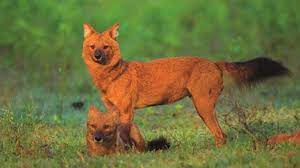08 Feb 2022 Dhole: Asian wild dog

- A new study reports a reappearance in the high mountains of Central Asia nearly 30 years after the last recorded appearance of the dhole or Asiatic wild dog.
- The presence of a drum has been observed at the Bek-Tosot Conservancy, located in the Osh region of southern Kyrgyzstan, a few kilometers from the Tajikistan border. It is located in the Pamir mountain range of the Xinjiang Autonomous Region of China.
Dhole:
- The dhole (Cuon alpinus) is a wild carnivorous animal that is a member of the Canidae family and the mammalian class.
- It is also called ‘Asiatic Wild Dog’.
Natural Habitat:
- Historically, drums have been found throughout southern Russia, Central Asia, South Asia and Southeast Asia.
- According to recent research and currently obtained maps, dholes are now restricted to South and Southeast Asia with the northernmost region only in China.
- In India these are found in three regions i.e. Western and Eastern Ghats, Central Indian landscape and North-East India.
- According to a new recent study, Karnataka, Maharashtra and Madhya Pradesh rank high in the conservation of endangered dholes in India.
- Ecological role: Dhole play an important role as top predators in the forest ecosystem.
Protection Status of Dhole:
- It is listed as Endangered in the IUCN Red List.
- Convention on International Trade in Endangered Species of Wildlife and Flora (CITES): Appendix II
- Listed in Schedule II under the Wildlife (Protection) Act, 1972 [Wildlife (Protection) Act].
Population Decline:
- Loss of Habitat: Due to deforestation and fragmentation of forest corridors, their habitat area is decreasing.
- Lack of Prey: The population of ungulates, the main prey of the dhole, is rapidly declining due to their hunting and habitat loss.
- Due to hunting of animals and diseases transmitted to them from domesticated dogs.


No Comments